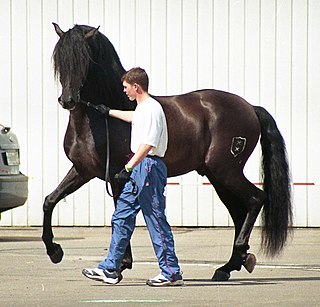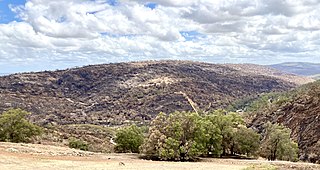
Horse breeding is reproduction in horses, and particularly the human-directed process of selective breeding of animals, particularly purebred horses of a given breed. Planned matings can be used to produce specifically desired characteristics in domesticated horses. Furthermore, modern breeding management and technologies can increase the rate of conception, a healthy pregnancy, and successful foaling.

Thoroughbred horse racing is a spectator sport in Australia, and gambling on horse races is a very popular pastime with A$14.3 billion wagered in 2009/10 with bookmakers and the Totalisator Agency Board (TAB). The two forms of Thoroughbred horseracing in Australia are flat racing, and races over fences or hurdles in Victoria and South Australia. Thoroughbred racing is the third most attended spectator sport in Australia, behind Australian rules football and rugby league, with almost two million admissions to 360 registered racecourses throughout Australia in 2009/10. Horseracing commenced soon after European settlement, and is now well-appointed with automatic totalizators, starting gates and photo finish cameras on nearly all Australian racecourses.

The Arabian or Arab horse is a breed of horse that originated on the Arabian Peninsula. With a distinctive head shape and high tail carriage, the Arabian is one of the most easily recognizable horse breeds in the world. It is also one of the oldest breeds, with archaeological evidence of horses in the Middle East that resemble modern Arabians dating back 4,500 years. Throughout history, Arabian horses have spread around the world by both war and trade, used to improve other breeds by adding speed, refinement, endurance, and strong bone. Today, Arabian bloodlines are found in almost every modern breed of riding horse.

The Lipizzan or Lipizzaner is a European breed of riding horse developed in the Habsburg Empire in the sixteenth century. It is of Baroque type, and is powerful, slow to mature and long-lived; the coat is usually gray.

The Cleveland Bay is a breed of horse that originated in England during the 17th century, named after its colouring and the Cleveland district of Yorkshire. It is a well-muscled horse, with legs that are strong but short in relation to the body. The horses are always bay in colour, although a few light hairs in the mane and tail are characteristic of some breed lines. It is the oldest established horse breed in England. The ancestors of the breed were developed during the Middle Ages for use as pack horses, when they gained their nickname of "Chapman Horses". These pack horses were cross-bred with Andalusian and Barb blood, and later with Arabians and Thoroughbreds, to create the Cleveland Bay of today. Over the years, the breed became lighter in frame as they were employed more as carriage and riding horses. The popularity of the Cleveland Bay has greatly fluctuated since it was first imported to the United States in the early nineteenth century. Despite serious declines in the population after the Second World War, the breed has experienced a resurgence in popularity since the 1970s, although only around 550 horses existed worldwide as of 2006.

The Lusitano, also known as the Pure Blood Lusitano or PSL, is a Portuguese horse breed. Horses were known to be present on the Iberian Peninsula as far back as 20,000 BC, and by 800 BC the region was renowned for its war horses. The fame of the horses from Lusitania goes back to the Roman Age, which attributed its speed to the influence of the West wind, who was considered capable of fertilizing the mares. When the Muslims invaded Iberia in 711 AD, they brought Arabian horses with them that were crossed with the native horses, developing a horse that became useful for war, dressage and bull fighting. The Portuguese horse was named the Lusitano, after the word Lusitania, the ancient Roman name for the region that modern Portugal occupies. There are four main breed lineages within the breed today, and characteristics differ slightly between each line.

The Azteca is a horse breed from Mexico, with a subtype, called the "American Azteca", found in the United States. They are well-muscled horses that may be of any solid color, and the American Azteca may also have Paint coloration. Aztecas are known to compete in many western riding and some English riding disciplines. The Mexican registry for the original Azteca and the United States registries for the American Azteca have registration rules that vary in several key aspects, including ancestral bloodlines and requirements for physical inspections. The Azteca was first developed in Mexico in 1972, from a blend of Andalusian, American Quarter Horse and Mexican Criollo bloodlines. From there, they spread to the United States, where American Paint Horse blood was added.
Secret Valley is an Australian children's television adventure series first shown on the ABC in 1980. It was produced by the Grundy Organisation in association with Telecip, S.A. and Spain's public broadcaster Televisión Española.

Malaga is a suburb of Perth, Western Australia, approximately 11 kilometres north of the CBD, in the City of Swan.
Wooroloo is a town on the outer fringe of the Perth metropolitan region, located off Great Eastern Highway in the eastern part of the Shire of Mundaring. At the 2021 census, Wooroloo had a population of 2,613.

The Shire of Mundaring is a local government area in eastern metropolitan Perth, the capital of Western Australia. The Shire covers an area of 645 square kilometres (249 sq mi) and had a population of approximately 38,000 as at the 2016 Census.
El Caballo Blanco is the name for equine Andalusian theme parks that operated in the south-western Sydney suburb of Catherine Field between 1972 and 2007; and in the north-eastern Perth suburb of Wooroloo in Western Australia since 1974.

The Mallorquín or Caballo Mallorquín is a rare breed of horse indigenous to the island of Mallorca in the Balearic Islands, from which it takes its name. Identification of the breed was begun in 1981 by the Patronato para las Razas Autóctonas de Mallorca. The Mallorquín is listed in the Catálogo Oficial de Razas de Ganado de España in the group of autochthonous breeds in danger of extinction.

The Andalusian, also known as the Pure Spanish Horse or PRE, is a horse breed from the Iberian Peninsula, where its ancestors have lived for thousands of years. The Andalusian has been recognized as a distinct breed since the 15th century, and its conformation has changed very little over the centuries. Throughout its history, it has been known for its prowess as a war horse, and was prized by the nobility. The breed was used as a tool of diplomacy by the Spanish government, and kings across Europe rode and owned Spanish horses. During the 19th century, warfare, disease and crossbreeding reduced herd numbers dramatically, and despite some recovery in the late 19th century, the trend continued into the early 20th century. Exports of Andalusians from Spain were restricted until the 1960s, but the breed has since spread throughout the world, despite their low population. In 2010, there were more than 185,000 registered Andalusians worldwide.
Marji Armstrong is one of the pioneers of the classical philosophy of horsemanship in Australia. She has taught these classical principles to students around the world for the past two decades, both in person and via the internet, and now shares her thoughts and experience on Marji's Blog.

The Yeguada Militar de Jerez de la Frontera, known outside Spain as the Yeguada Militar, is a military Spanish stud farm headquartered in Andalusia, Spain, dedicated to horse breeding of purebred Andalusian horses and Arabian horses. Founded in 1847, it became the state military stud farm in 1893. In the 20th century, as need for cavalry horses declined, the stud's emphasis shifted to become a genetic reservoir to preserve the bloodlines of the Pure Spanish Horse and to continue to breed high quality Arabian horses, with stallions of both breeds being made available to private horse breeders to improve the horses of Spain. Today, there are two facilities located in the Jerez de la Frontera area, one primarily for stallions, the other for mares and foals, as well as multiple stallion depots across the country.

Royal Stables are a set of stables in Córdoba, Spain. The building is situated in the historic centre and borders the Guadalquivir. The stables housed the best stallions and mares of the royal stud breed Andalusian horse.

The Spanish Trotter, Spanish: Trotador Español, is the national breed of trotting horse of Spain. It is reared almost exclusively in the Balearic Islands in the Mediterranean, predominantly in the island of Mallorca, but also in Menorca and Ibiza.

The 2021 Wooroloo bushfire was a fast moving bushfire that started on 1 February in Wooroloo, 45 kilometres (28 mi) north-east of the Perth central business district, in the Shire of Mundaring, Western Australia. By 2 February, the bushfire emergency had spread to Shires of Chittering and Northam, and the City of Swan. It had destroyed at least 86 houses and 2 fire trucks. By 6 February, the bushfire had travelled 26 km (16 mi) from its source. The fire coincided with a five day lockdown of the Perth metropolitan region that started at 6pm on 31 January, due to a case of COVID-19 outside of hotel quarantine. In July 2021, WA Police charged a man with a breach of duty and carrying out an activity that could cause a fire, alleging that he used an angle grinder that caused sparks.

The Carthusianhorse, sometimes known as Cartujano in Spanish, is a prestigious lineage of Purebred Spanish horses. Created in 1476, its breed registry is one of the oldest in the world. Related to the PRE and the Lusitano with which it is often confused, the Carthusian lineage descends from a gray stallion named Esclavo, who became the property of the Carthusian monks of Andalusia. The monks made a success of this breeding, which became famous throughout Europe in the 18th century. The Carthusian horse is morphologically distinguished from the PRE by its lighter body and straighter head profile, with the possible presence of bony protuberances. Likewise, the Carthusian coat is more frequently gray, and they are culturally valued in Spain since they are usually perceived as white. The Carthusian makes an excellent dressage horse and is well suited to combined driving. Carthusian breeding is concentrated in its birthplace, Andalusia, around Jerez de la Frontera, Badajoz and Cordoba.















